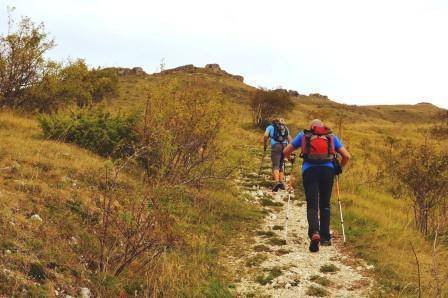Keeping ticks and mosquitoes away in the great outdoors serves many purposes. It makes your time outside more comfortable, but it might also prevent severe health issues. Mosquitoes carry the West Nile Virus, Zika, and several other illnesses that can affect humans. Ticks carry dreaded Lyme disease and Rocky Mountain Spotted Fever.
The good news is that these diseases should be preventable. The bad news is that if you are a hiker, camper, or outdoors explorer, you are putting yourself squarely in the “risk” area when you go out.
Just as important as having hydration, sun protection, and a map along when you venture outside, take some care to be sure you keep ticks and mosquitoes off of you and your pets.

Beware of Your Surroundings
Tick and mosquito habitat often overlaps with the area that outdoorsy people want to spend time in. One of the main things you can do is to be aware of where you are going, and what the risks are.
For ticks, know that they like areas with long grass, lots of trees or shrubs, and brush. Ticks “jump” on to you as you walk by, so they like to be a little elevated from the ground. If you happen to go off-trail into some thigh-high grass for a stroll, there is a very good chance that ticks will be waiting to hitch a ride.
You need to be most concerned about the black-legged or deer tick, the one that carries Lyme disease. For most nature lovers, the riskiest areas in the US are the Northeast and Central states. However, ticks are aggressively expanding their range, and as the climate changes ticks are quick to claim new territory.
When it comes to mosquitoes, no state is safe. It is true that the classic mosquito territory is assumed to be the beautiful Northwoods with all of its forests, lakes, and water, but the fact is they are everywhere. What’s more, the sicker mosquitoes tend to live in drier states. Your chances of getting West Nile Virus are higher on the hiking trail in Colorado or California than they are in Wisconsin or Maine.
Mosquitoes love areas near a water source, and if the water is not moving or not deep, even better. They also tend to be most active at dusk, so it is possible that you won’t see a mosquito all day, but when you set up your tent and sit outside at sunset, they will appear.
Use Repellents

An effective repellent or combination of repellents can work really well when it comes to both ticks and mosquitoes. Repellents sometimes get a bad rap, because people smell them and assume they are made of harmful chemicals. It is true that many man-made repellents are meant to be used as directed — anything in excess is not good. But all repellents on the market today are approved by the EPA.
When it comes to ticks, the repellent we like best is actually a combination of two, per this tick repellent guide. Deet works great on the skin, while permethrin is not meant for skin but does wonders on clothing and footwear. If you will be in a tick-heavy area, this combination is proven to be really effective. Note that permethrin only needs to be applied to clothing and boots every few wears, while Deet needs to be applied to the skin multiple times per day.
People often ask about essential oils and natural methods for getting rid of ticks, and there are some promising studies based on oils like nootkatone, geraniol, and rosemary. They could be useful against ticks, but you can’t hang your hat on those solutions the way you can on proven, tested tick repellents like the ones listed above. Lyme disease is not something you want to take your chance with!
As for mosquito repellents, the story is somewhat similar although more and more data is emerging that some natural solutions can work quite well against skeeters.
The top mosquito repellent out there is DEET, which comes in many concentrations. What does a different concentration of DEET do? Many don’t know this, but it actually means you can go longer before you reapply. A higher % of DEET doesn’t necessarily keep more mosquitoes away at a time, but it will keep them away for a longer period of time.
Another great mosquito repellent is picaridin. Like Deet, it is synthetic but works very well on mosquitoes. For the most part, you can use DEET and picaridin interchangeably, although DEET generally works better on other critters like ticks or black flies if you are trying to repel multiple species with one chemical.
Wear the Right Clothes

Wearing the right clothing when heading out into a known tick or mosquito-infested area is critical. The last thing you want is to make it easy for the bugs, allowing them to effortlessly find your skin and attack you.
Wearing clothing that is suited for bug-heavy areas is a smart move. A lightweight long-sleeved bug shirt (like these), and longer lightweight pants can do wonders against bugs and still feel nearly as comfortable as shorts and a short-sleeve shirt.
Some brands actually treat the clothing with permethrin during the construction process, allowing the clothes to be extra-effective against bugs for many, many washes. These garments are worth considering if you fear that you will need to spend time in an area where you are concerned about picking up Lyme disease.
Whatever you wear, be sure it has long sleeves and legs, and having a collared shirt can be useful too. The good news is that taking all of these steps with your clothing will also help you reduce sun exposure, so theoretically you should need to spend less time lathering up with sunscreen before your hike or outing.
Do Regular Tick Checks
This might be stating the obvious, but stopping on occasion to make sure you don’t have any ticks planning to attach to your skin is not only a good idea but imperative. When you do a tick check, you want to do a pretty thorough review, not just a passing glance. That involves using your hands and making sure you don’t feel anything abnormal.
It is great to look at the obvious parts, but remember that ticks love hot spots. As such, be sure you feel around behind your ears, your knees, in your armpits, and yes, your nether regions. It is better to look a little awkward for a second than to have the wrong tick attach to you.
Don’t Forget About Your Pets

If your dog is joining you for a hike, don’t forget to include them in your tick or mosquito prevention plan. They are just as important to protect as you are. Dogs tend to find their way into long grass and brush piles and are likely to find themselves in areas that will kick up ticks, mosquitoes, black flies, or other nuisance bugs. Besides, the dogs will become the host for the ticks, which can then join you in your car or home after the outing is over.
Be sure to use tick and mosquito preventers, including flea and tick medicine, before heading out with your dog. They come in many forms.





